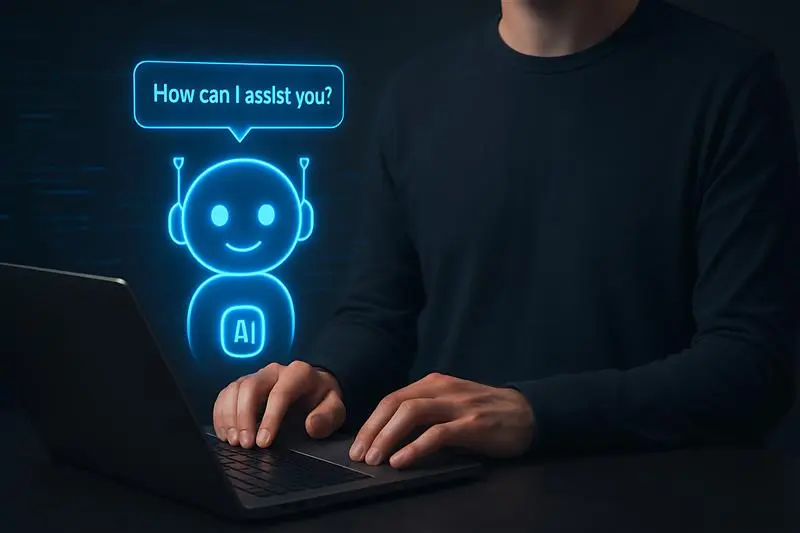Why Today’s AI Chatbots Do More Than Just Answer Questions

Introduction
A few years ago, chatbots were little more than automated question-and-answer systems — useful, but limited. They could tell you the weather, confirm an order, or redirect you to a human agent. But that was about it. Fast forward to today, and AI chatbots have evolved into intelligent digital assistants that not only respond but understand, predict, and act.
In the age of hyper-personalization and instant gratification, customers expect more than fast replies — they expect meaningful conversations. Modern AI chatbots are now capable of holding context-rich interactions, automating workflows, generating leads, analyzing sentiment, and even driving conversions.
Thanks to advancements in natural language processing (NLP), machine learning (ML), and generative AI, these chatbots are transforming from reactive responders into proactive business tools that enhance engagement, streamline operations, and boost revenue.
This blog explores how today’s AI chatbots have transcended their original purpose — and why they’ve become essential for modern businesses.
1. From Simple Responders to Intelligent Conversational Partners
The earliest chatbots were rule-based — they followed scripted responses triggered by specific keywords. If you asked anything outside their script, you’d get an awkward “I don’t understand” message.
Modern AI chatbots, however, have come a long way. Powered by machine learning and NLP, they can interpret the intent behind user queries, adapt to language variations, and learn from past interactions.
For example, when a customer says, “I want to change my subscription plan,” an intelligent chatbot recognizes the intent (“modify account”) and provides tailored options instead of just offering generic answers.
These chatbots don’t just “hear” — they listen, learn, and personalize.
2. The Evolution of Chatbots: From Rules to Real Conversations
Let’s briefly look at how chatbots have evolved:
- Rule-based Chatbots (Early 2010s): Operated through pre-defined scripts and decision trees. Could only handle simple FAQs.
- AI-powered Chatbots (Late 2010s): Introduced NLP and ML for better understanding of user intent.
- Contextual and Generative Chatbots (2020s): Today’s models, such as ChatGPT or Google Bard, generate dynamic, human-like conversations, maintain context, and perform real-time actions like bookings, payments, and recommendations.
This evolution marks a shift from transactional to relational communication — enabling businesses to create experiences that feel natural, helpful, and human.
3. Beyond Conversations: How AI Chatbots Add Real Business Value
Today’s AI chatbots don’t just talk — they drive business outcomes. Their roles have expanded far beyond answering questions to actively supporting operations, marketing, and customer experience.
Here’s how they’re making an impact:
a. Automating Routine Tasks
Modern chatbots handle repetitive administrative or customer support tasks such as:
- Booking appointments or demos
- Processing returns and refunds
- Updating user details
- Sending reminders or payment confirmations
This automation reduces manual workload and allows human teams to focus on complex, high-value interactions.
b. 24/7 Customer Engagement
AI chatbots never sleep. They provide round-the-clock support across time zones and languages, ensuring customers get instant assistance anytime. This not only boosts satisfaction but also enhances global brand presence.
c. Personalized Recommendations
By analyzing customer behavior, preferences, and purchase history, chatbots can offer highly personalized suggestions — much like a virtual shopping assistant. For example, an eCommerce chatbot can recommend complementary products or exclusive offers based on browsing patterns.
d. Lead Generation and Qualification
Modern chatbots are becoming sales enablers. They engage website visitors, capture contact details, qualify leads by asking relevant questions, and even schedule meetings with sales teams. This shortens the sales cycle and improves conversion rates.
e. Data Collection and Analytics
Every conversation is a data point. Chatbots collect valuable insights about customer needs, pain points, and buying behavior. This real-time feedback helps businesses improve products, marketing strategies, and customer experiences.
4. How AI Chatbots Are Revolutionizing Customer Experience
Today’s customers want seamless experiences — not just solutions. AI chatbots deliver that by being context-aware, empathetic, and adaptive.
Here’s how they’re transforming customer experience:
a. Contextual Understanding
Unlike older systems that treated every question as isolated, modern chatbots maintain context. They remember what was said earlier in the conversation and use it to personalize responses.
For example:
User: “I ordered a laptop last week.”
Bot: “Yes, your Dell Inspiron was shipped yesterday and will arrive by Thursday.”
This continuity builds trust and makes the user feel genuinely understood.
b. Emotional Intelligence and Tone Adaptation
Advanced AI chatbots can detect the sentiment behind messages — whether a user is frustrated, happy, or confused — and adjust tone accordingly. A frustrated customer might receive empathetic responses, while a casual shopper gets a friendly tone.
c. Omni-channel Consistency
Chatbots now operate across multiple platforms — websites, WhatsApp, Facebook Messenger, mobile apps, and voice assistants — ensuring consistent communication everywhere. No matter where the customer interacts, the chatbot remembers their journey and provides unified support.
5. Industry Applications: AI Chatbots in Action
AI chatbots are reshaping industries across the board. Let’s look at some real-world applications:
a. Retail and eCommerce
- Personalized shopping assistance
- Order tracking and returns
- Upselling and cross-selling suggestions
- Automated cart recovery reminders
b. Banking and Finance
- Real-time balance checks and transaction summaries
- Fraud detection alerts
- Personalized investment advice
- Loan application guidance
c. Healthcare
- Appointment scheduling
- Symptom checking and triage
- Medication reminders
- Patient engagement and follow-up
d. Education and E-Learning
- Virtual tutors for students
- Automated grading and quiz feedback
- Course recommendations based on learning style
- 24/7 student support
e. Travel and Hospitality
- Booking confirmations and itinerary management
- Real-time flight or hotel updates
- Personalized travel recommendations
- Complaint management during travel disruptions
In each case, chatbots are doing far more than answering questions — they’re enhancing productivity, efficiency, and customer satisfaction.
6. The Role of Generative AI: Making Chatbots Truly Conversational
Generative AI — the technology behind platforms like GPT — has completely changed how chatbots function.
Unlike traditional AI that relies on fixed responses, generative AI creates unique, contextually relevant answers each time. It understands language patterns, tone, and even emotion, making interactions feel human-like.
Key generative AI capabilities include:
- Dynamic Response Generation: Produces natural and varied sentences rather than robotic replies.
- Knowledge Expansion: Can access and synthesize large amounts of data to answer complex queries.
- Context Retention: Remembers previous exchanges to maintain fluid conversations.
- Task Execution: Integrates with CRM, ERP, or marketing tools to execute actions directly from chat.
As a result, businesses are deploying chatbots not only for support but also for sales, marketing, onboarding, and internal operations.
7. How AI Chatbots Boost Business Efficiency
Beyond customer service, AI chatbots are transforming internal workflows. Many organizations now use internal bots to:
- Manage employee onboarding and FAQs
- Streamline IT helpdesk support
- Automate HR-related requests (leave, attendance, payroll)
- Facilitate internal communications across departments
These chatbots cut down response times, reduce costs, and improve employee productivity — ultimately driving organizational efficiency.
8. Challenges and the Road Ahead
Despite their progress, chatbots still face challenges. Some customers prefer human interactions, and maintaining data privacy remains a concern. Additionally, businesses must ensure that chatbot responses remain accurate, ethical, and bias-free.
However, with advances in AI ethics, multilingual models, and real-time learning, these challenges are rapidly being addressed. The next phase of chatbot evolution will focus on hyper-personalization, emotional intelligence, and human-AI collaboration.
Soon, chatbots won’t just assist — they’ll anticipate needs and act autonomously to enhance both customer and business outcomes.
Conclusion
AI chatbots have evolved far beyond their original role of answering questions. They’ve become strategic assets — capable of understanding human intent, automating processes, and delivering personalized experiences that customers remember.
By integrating AI-driven chatbots, businesses can reduce operational costs, increase engagement, and build stronger, trust-based relationships with their customers.
In the modern digital ecosystem, chatbots are not just tools — they’re partners in growth. They listen, learn, and act intelligently to bridge the gap between business efficiency and customer satisfaction.
As technology continues to advance, one thing is clear:
The future of communication isn’t just conversational — it’s intelligent.
Table of content
- Introduction
- 1. Why Cloud Security Equals Customer Trust
- 2. The Rising Threat Landscape in the Cloud
- 3. Core Pillars of Cloud Security
- 4. How Cloud Security Builds Competitive Advantage
- 5. The Role of Transparency in Building Trust
- 6. Shared Responsibility: The Business and the Cloud Provider
- 7. Leveraging AI and Automation in Cloud Security
- 8. Building a Security-first Culture
- Conclusion










